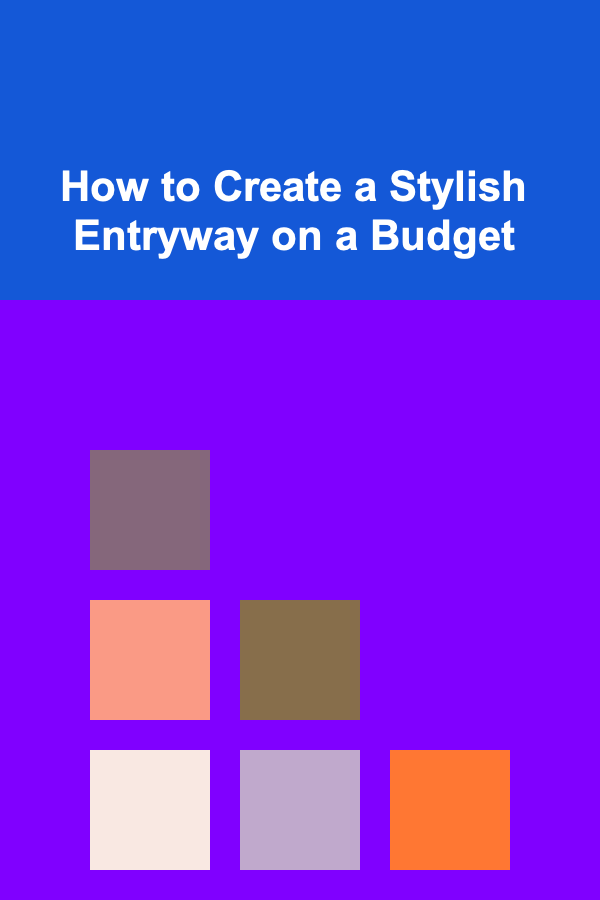
How to Combine Screen Printing and Collage
ebook include PDF & Audio bundle (Micro Guide)
$12.99$8.99
Limited Time Offer! Order within the next:

Screen printing and collage are two distinct art forms, each with its own techniques, history, and creative possibilities. However, when combined, they create a unique fusion of textures, layers, and visual impact that can be both captivating and deeply expressive. Whether you're an artist, a designer, or someone interested in exploring new methods of visual storytelling, combining screen printing and collage can open up a world of creative potential.
In this article, we'll explore the ways in which you can effectively combine screen printing and collage, the benefits of doing so, and practical tips to help you create innovative works of art that harness the strengths of both techniques.
Understanding Screen Printing
Screen printing, also known as silk screening, is a printmaking technique where ink is pushed through a screen (mesh fabric) onto a surface, typically paper or fabric, to create an image or pattern. This process involves creating a stencil (or screen) of the design, then using a mesh frame to transfer the ink onto the desired material.
Key Characteristics of Screen Printing:
- Layered Effects: Screen printing involves creating separate layers of color, often using different screens for each color. This allows for vibrant, dynamic compositions with bold lines and distinct shapes.
- Bold Lines and Colors: The process emphasizes solid, uninterrupted color and shape, which makes it great for creating graphic, eye-catching visuals.
- Versatility: Screen printing can be applied to a variety of materials such as paper, fabric, and wood, allowing for a wide range of artistic expression.
- Repeatability: Once you have your screen, you can print multiple copies of the same design, making it ideal for mass production, limited edition prints, or merchandise.
Understanding Collage
Collage, on the other hand, is a technique that involves assembling different elements---often from magazines, newspapers, photographs, or found objects---into a single composition. These elements are glued, taped, or otherwise affixed to a backing, often creating an image that seems fragmented or multi-dimensional.
Key Characteristics of Collage:
- Mixed Media: Collage typically uses a range of materials, including paper, fabric, photographs, and even three-dimensional objects, to create a multi-layered, textured artwork.
- Fragmented Aesthetic: Collage often involves the juxtaposition of different styles, textures, and imagery, resulting in compositions that feel disjointed or fragmented, yet harmonious in their own way.
- Layered Visual Impact: The different materials in a collage can create a tactile, almost sculptural quality, especially when combined with screen-printed elements, which add depth and contrast.
- Surreal and Narrative Possibilities: Collage lends itself well to experimental and surreal compositions. Artists can mix and match various elements to create new narratives or abstract representations.
The Creative Potential of Combining Screen Printing and Collage
Combining screen printing with collage allows you to explore the visual relationship between different mediums and textures. The result is a unique hybrid of flat, graphic design with tactile, three-dimensional elements. The interplay between bold, uniform shapes and intricate, layered textures can produce striking and unexpected effects.
Here are some reasons why combining these two techniques can be so powerful:
- Texture and Dimension: Collage introduces texture through various materials, while screen printing creates a flat, bold design. Combining them adds depth to your work, giving it a tactile quality that can't be achieved through one technique alone.
- Contrast and Harmony: Screen printing offers clean lines and defined shapes, while collage often includes fragments of images and organic shapes. Together, they create a visually dynamic contrast between order and chaos, which can make the piece more engaging.
- Layered Meaning: The layers of collage can convey complex ideas or emotions, while screen printing can reinforce certain key elements, such as a central image or message. This layered approach enhances the narrative potential of your work.
- Personalization and Uniqueness: Combining screen printing with collage gives you the freedom to create something entirely original, as you can manipulate both techniques to create a work that feels distinct and personal.
- Mixed Media Possibilities: The fusion of two distinct art forms invites further experimentation with other materials, such as ink washes, textured paper, or even fabric, expanding the possibilities of what can be included in your artwork.
Practical Tips for Combining Screen Printing and Collage
Combining screen printing and collage requires a bit of planning and experimentation. While the two techniques are relatively simple individually, together they can be quite complex. Here are some practical tips to help you combine these two techniques seamlessly:
1. Plan Your Composition Ahead of Time
The first step in any collage or screen printing project is to plan your composition. Think about how the screen printing and collage elements will interact. Do you want the screen print to be the focal point of the artwork, or would you prefer to use it as a background to support the collage?
- Consider Layers: One way to think about this is to plan how each medium will function within a layered structure. Screen print certain elements first, then build the collage around those elements, or vice versa. The order in which you apply each medium will greatly influence the final outcome.
- Work with Scale: Make sure the scale of the printed elements and collage pieces complement one another. The printed elements might be larger or more bold, while the collage materials might be smaller or more intricate.
2. Start with Screen Printing
One common approach is to start with the screen printing process before adding the collage elements. This ensures that the printed elements form a strong foundation for the rest of the artwork.
- Use Transparent or Layered Screens: Experiment with transparency by printing in layers. You can screen print different designs or colors over each other to create depth. This can serve as a background or anchor for your collage elements.
- Print on Various Surfaces: Consider screen printing on different types of materials, such as colored paper, fabric, or textured cardstock. These materials can provide an interesting contrast to the collage elements you plan to add.
3. Incorporate Collage Elements Gradually
Once your screen printing has dried, start adding collage elements. Because collage is inherently about layering materials, you can experiment with different textures, images, and patterns.
- Use Found Objects: Collage works well with unconventional materials. Try incorporating small objects like fabric scraps, buttons, or magazine cutouts to enhance the tactile quality of your artwork.
- Create Contrast with Paper and Mixed Media: Use contrasting paper textures, such as glossy magazine pages or rough handmade paper, alongside your screen-printed images. This adds visual interest and highlights the differences between the two techniques.
4. Balance and Harmonize Your Composition
When combining these techniques, it's important to create a balanced composition. Screen printing is bold, while collage can be fragmented or even chaotic. Think about how you can bring harmony between these two extremes.
- Limit Your Color Palette: To maintain visual harmony, use a consistent color palette across both your screen prints and collage materials. This ensures that the two elements work together as a cohesive whole.
- Emphasize Focal Points: Consider where you want the viewer's eye to be drawn first. The bold lines of screen printing can direct attention to certain areas, while the collage can provide secondary focal points. Work with contrast to guide the viewer's gaze through the composition.
5. Experiment with Layering Techniques
Collage is all about layers, and screen printing can help create the structural foundation for these layers. Try combining different types of paper, textures, and even three-dimensional elements.
- Cut, Tear, and Fold: Experiment with cutting and tearing your collage elements to create irregular edges that interact interestingly with the clean lines of your screen print.
- Overlapping Collage Pieces: You can overlap collage elements with screen-printed areas, using transparent materials like tracing paper to create subtle layering effects.
6. Consider Texture and Material Interaction
One of the most exciting aspects of combining screen printing and collage is the potential for textural contrast. Use the different qualities of materials to your advantage.
- Tactile Elements: Consider adding fabric or textured paper to your collage. These materials add depth to the artwork, which is contrasted by the flatness of the screen print.
- Ink and Collage Interaction: Experiment with screen printing in different types of ink---such as metallics or glazes---that interact interestingly with paper or other collage materials. This can give the entire composition a more dynamic feel.
7. Final Touches and Layering
Once the collage and screen print are combined, don't be afraid to add final touches to unify the artwork.
- Additional Printing: If necessary, you can do another round of screen printing over the completed collage to sharpen certain elements or add more color and texture.
- Surface Treatment: Consider varnishing or adding texture to the surface of your artwork to seal the collage materials and enhance the overall finish.
Conclusion
Combining screen printing and collage offers limitless possibilities for artistic expression. Both techniques bring their own set of strengths to the table---screen printing with its bold, graphic clarity and collage with its texture, depth, and narrative potential. By thoughtfully blending these two mediums, you can create artworks that are dynamic, multi-dimensional, and rich in both visual and conceptual complexity.
Whether you're a seasoned printmaker or just beginning to explore these techniques, don't be afraid to experiment. The fusion of screen printing and collage allows you to push the boundaries of traditional art-making, offering fresh ways to engage with your materials and ideas.
Reading More From Our Other Websites
- [Home Storage Solution 101] How to Choose the Perfect Living Room Storage Furniture to Declutter Your Space
- [Home Lighting 101] How to Layer Lighting in a Small Apartment
- [Home Staging 101] How to Stage for a High-End Market: Tips for Luxury Home Staging
- [Soap Making Tip 101] Eco-Conscious Creations: Tackling Sustainability Challenges in DIY Soap Production
- [Trail Running Tip 101] How to Master Trail Running on Loose Gravel Paths Without Losing Pace
- [Beachcombing Tip 101] From Shells to Seaweed: Ethical Practices for Sustainable Beach Finds
- [Home Staging 101] How to Stage a Home with Pets in Mind
- [Home Security 101] How to Install Smart Home Security Devices on a Budget
- [Polymer Clay Modeling Tip 101] Step-by-Step Guide to Perfectly Cured Polymer Clay Every Time
- [Whitewater Rafting Tip 101] Behind the Scenes: A Day in the Life of a River Rafting Guide

How to Clean Your Home With Natural and Eco-Friendly Products
Read More
How to Create a Stylish Entryway on a Budget
Read More
How to Help Students Build a Strong Video Portfolio: An Actionable Guide
Read More
How To Discover the Hanging Gardens of Babylon: A Journey Through History, Archaeology, and Persistent Mystery
Read More
How to Navigate Nurse Residency Programs
Read More
How to Accurately Track Lost Wages in Workers' Comp Claims
Read MoreOther Products

How to Clean Your Home With Natural and Eco-Friendly Products
Read More
How to Create a Stylish Entryway on a Budget
Read More
How to Help Students Build a Strong Video Portfolio: An Actionable Guide
Read More
How To Discover the Hanging Gardens of Babylon: A Journey Through History, Archaeology, and Persistent Mystery
Read More
How to Navigate Nurse Residency Programs
Read More